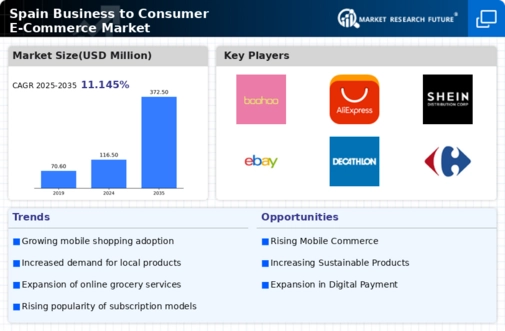The business to-consumer-e-commerce market in Spain is characterized by a dynamic competitive landscape, driven by rapid technological advancements and shifting consumer preferences. Major players such as Amazon (US), Alibaba (CN), and Zalando (DE) are at the forefront, each employing distinct strategies to capture market share. Amazon (US) continues to enhance its logistics capabilities, focusing on same-day delivery services, which positions it as a leader in customer satisfaction. Meanwhile, Alibaba (CN) emphasizes its stronghold in cross-border e-commerce, leveraging its extensive network to facilitate international transactions. Zalando (DE), on the other hand, is concentrating on sustainability initiatives, aiming to reduce its carbon footprint while appealing to environmentally conscious consumers. Collectively, these strategies contribute to a competitive environment that is increasingly focused on innovation and customer-centric solutions.
Key business tactics within this market include localized manufacturing and supply chain optimization, which are essential for meeting the diverse needs of Spanish consumers. The competitive structure appears moderately fragmented, with several key players exerting influence over various segments. This fragmentation allows for niche players to thrive, while larger companies leverage economies of scale to enhance their market presence. The interplay between these dynamics fosters a competitive atmosphere where agility and responsiveness to consumer trends are paramount.
In October 2025, Amazon (US) announced the expansion of its Prime Air drone delivery service in Spain, aiming to reduce delivery times to under 30 minutes for select products. This strategic move not only enhances customer convenience but also positions Amazon (US) as a pioneer in the integration of drone technology within e-commerce logistics. The implications of this development could be profound, potentially setting new standards for delivery efficiency in the market.
In September 2025, Alibaba (CN) launched a new initiative aimed at supporting Spanish small and medium-sized enterprises (SMEs) in accessing global markets through its platform. This initiative is significant as it not only strengthens Alibaba's position in Spain but also fosters local economic growth by empowering SMEs to expand their reach. Such strategic actions may enhance Alibaba's brand perception as a facilitator of international trade, thereby attracting more users to its platform.
In August 2025, Zalando (DE) unveiled its "Sustainability Strategy 2025," which includes commitments to achieve carbon neutrality across its operations by 2025. This initiative reflects a growing trend among consumers who prioritize sustainability in their purchasing decisions. By positioning itself as a leader in sustainable fashion, Zalando (DE) is likely to differentiate itself from competitors, appealing to a demographic increasingly concerned with environmental impact.
As of November 2025, the competitive trends within the business to-consumer-e-commerce market are heavily influenced by digitalization, sustainability, and the integration of artificial intelligence (AI). Strategic alliances are becoming more prevalent, as companies seek to enhance their technological capabilities and expand their service offerings. The shift from price-based competition to a focus on innovation, technology, and supply chain reliability is evident, suggesting that future competitive differentiation will hinge on these factors. Companies that can effectively leverage technology and sustainability will likely emerge as leaders in this evolving landscape.

















Leave a Comment